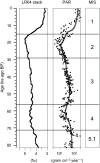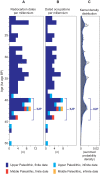Climate amelioration, abrupt vegetation recovery, and the dispersal of Homo sapiens in Baikal Siberia
- PMID: 37738346
- PMCID: PMC10516500
- DOI: 10.1126/sciadv.adi0189
Climate amelioration, abrupt vegetation recovery, and the dispersal of Homo sapiens in Baikal Siberia
Abstract
The dispersal of Homo sapiens in Siberia and Mongolia occurred by 45 to 40 thousand years (ka) ago; however, the climatic and environmental context of this event remains poorly understood. We reconstruct a detailed vegetation history for the Last Glacial period based on pollen spectra from Lake Baikal. While herb and shrub taxa including Artemisia and Alnus dominated throughout most of this period, coniferous forests rapidly expanded during Dansgaard-Oeschger (D-O) events 14 (55 ka ago) and 12 to 10 (48 to 41 ka ago), with the latter presenting the strongest signal for coniferous forest expansion and Picea trees, indicating remarkably humid conditions. These abrupt forestation events are consistent with obliquity maxima, so that we interpret last glacial vegetation changes in southern Siberia as being driven by obliquity change. Likewise, we posit that major climate amelioration and pronounced forestation precipitated H. sapiens dispersal into Baikal Siberia 45 ka ago, as chronicled by the appearance of the Initial Upper Paleolithic.
Figures









Similar articles
-
Pollen-based reconstruction of vegetational and climatic change over the past ~30 ka at Shudu Lake in the Hengduan Mountains of Yunnan, southwestern China.PLoS One. 2017 Feb 9;12(2):e0171967. doi: 10.1371/journal.pone.0171967. eCollection 2017. PLoS One. 2017. PMID: 28182711 Free PMC article.
-
1.36 million years of Mediterranean forest refugium dynamics in response to glacial-interglacial cycle strength.Proc Natl Acad Sci U S A. 2021 Aug 24;118(34):e2026111118. doi: 10.1073/pnas.2026111118. Proc Natl Acad Sci U S A. 2021. PMID: 34400496 Free PMC article.
-
Evidence for a humid interval at ∼56-44 ka in the Levant and its potential link to modern humans dispersal out of Africa.J Hum Evol. 2018 Nov;124:75-90. doi: 10.1016/j.jhevol.2018.08.002. Epub 2018 Sep 1. J Hum Evol. 2018. PMID: 30177446
-
The climate and vegetation backdrop to hominin evolution in Africa.Philos Trans R Soc Lond B Biol Sci. 2022 Apr 25;377(1849):20200483. doi: 10.1098/rstb.2020.0483. Epub 2022 Mar 7. Philos Trans R Soc Lond B Biol Sci. 2022. PMID: 35249389 Free PMC article. Review.
-
Tectonics of the baikal rift deduced from volcanism and sedimentation: a review oriented to the Baikal and Hovsgol lake systems.Prog Mol Subcell Biol. 2009;47:27-54. doi: 10.1007/978-3-540-88552-8_2. Prog Mol Subcell Biol. 2009. PMID: 19198772 Review.
Cited by
-
Initial Upper Palaeolithic material culture by 45,000 years ago at Shiyu in northern China.Nat Ecol Evol. 2024 Mar;8(3):552-563. doi: 10.1038/s41559-023-02294-4. Epub 2024 Jan 18. Nat Ecol Evol. 2024. PMID: 38238436
References
-
- U. C. Müller, J. Pross, P. C. Tzedakis, C. Gamble, U. Kotthoff, G. Schmiedl, S. Wulf, K. Christanis, The role of climate in the spread of modern humans into Europe. Quat. Sci. Rev. 30, 273–279 (2011).
-
- J.-J. Hulbin, The modern human colonization of western Eurasia: When and where? Quat. Sci. Rev. 118, 194–210 (2015).
-
- P. R. Nigst, P. Haesaerts, F. Damblon, C. Frank-Fellner, C. Mallol, B. Viola, M. Gotzinger, L. Niven, G. Trnka, J.-J. Hublin, Early modern human settlement of Europe north of the Alps occurred 43,500 years ago in a cold steppe-type environment. Proc. Natl. Acad. Sci. U.S.A. 111, 14394–14399 (2014). - PMC - PubMed
MeSH terms
LinkOut - more resources
Full Text Sources

